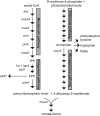Engineering Lactococcus lactis for Increased Vitamin K2 Production
- PMID: 32258010
- PMCID: PMC7093718
- DOI: 10.3389/fbioe.2020.00191
Engineering Lactococcus lactis for Increased Vitamin K2 Production
Abstract
Cheese produced with Lactococcus lactis is the main source of vitamin K2 in the Western diet. Subclinical vitamin K2 deficiency is common, calling for foods with enhanced vitamin K2 content. In this study we describe analyses of vitamin K2 (menaquinone) production in the lactic acid bacterium L. lactis ssp. cremoris strain MG1363. By cloning and expression from strong promoters we have identified genes and bottlenecks in the biosynthetic pathways leading to the long-chained menaquinones, MK-8 and MK-9. Key genes of the biosynthetic menaquinone pathway were overexpressed, singly or combined, to examine how vitamin K2 production can be enhanced. We observed that the production of the long menaquinone polyprenyl side chain, rather than production of the napthoate ring (1,4-dihydroxy-2-naphtoic acid), limits total menaquinone synthesis. Overexpression of genes causing increased ring formation (menF and menA) led to overproduction of short chained MK-3, while overexpression of other key genes (mvk and llmg_0196) resulted in enhanced full-length MK-9 production. Of two putatively annotated prenyl diphosphate synthases we pinpoint llmg_0196 (preA) to be important for menaquinone production in L. lactis. The genes mvk, preA, menF, and menA were found to be important contributors to menaquinone levels as single overexpression of these genes double and more than triple the total menaquinone content in culture. Combined overexpression of mvk, preA, and menA increased menaquinone levels to a higher level than obtained individually. When the overproducing strains were applied for milk fermentations vitamin K2 content was effectively increased 3-fold compared to the wild type. The results provide a foundation for development of strains to ferment foods with increased functional value i.e., higher vitamin K2 content.
Keywords: Lactococcus lactis; MK-3; MK-8; MK-9; menaquinone; mevalonate kinase; prenyl diphosphate synthase; vitamin K2.
Copyright © 2020 Bøe and Holo.
Figures




Similar articles
-
New aspects of microbial vitamin K2 production by expanding the product spectrum.Microb Cell Fact. 2021 Apr 13;20(1):84. doi: 10.1186/s12934-021-01574-7. Microb Cell Fact. 2021. PMID: 33849534 Free PMC article. Review.
-
Long-chain vitamin K2 production in Lactococcus lactis is influenced by temperature, carbon source, aeration and mode of energy metabolism.Microb Cell Fact. 2019 Aug 6;18(1):129. doi: 10.1186/s12934-019-1179-9. Microb Cell Fact. 2019. PMID: 31387603 Free PMC article.
-
Physiological Roles of Short-Chain and Long-Chain Menaquinones (Vitamin K2) in Lactococcus cremoris.Front Microbiol. 2022 Mar 15;13:823623. doi: 10.3389/fmicb.2022.823623. eCollection 2022. Front Microbiol. 2022. PMID: 35369466 Free PMC article.
-
Combinatorial engineering for improved menaquinone-4 biosynthesis in Bacillus subtilis.Enzyme Microb Technol. 2020 Nov;141:109652. doi: 10.1016/j.enzmictec.2020.109652. Epub 2020 Aug 23. Enzyme Microb Technol. 2020. PMID: 33051011
-
Biosynthesis of menaquinone (vitamin K2) and ubiquinone (coenzyme Q): a perspective on enzymatic mechanisms.Vitam Horm. 2001;61:173-218. doi: 10.1016/s0083-6729(01)61006-9. Vitam Horm. 2001. PMID: 11153266 Review.
Cited by
-
New aspects of microbial vitamin K2 production by expanding the product spectrum.Microb Cell Fact. 2021 Apr 13;20(1):84. doi: 10.1186/s12934-021-01574-7. Microb Cell Fact. 2021. PMID: 33849534 Free PMC article. Review.
-
Combination of SPH and SP80 prolongs the lifespan of Bacillus subtilis natto to enhance industrial menaquinone-7 biosynthesis.Front Microbiol. 2025 Jun 4;16:1578160. doi: 10.3389/fmicb.2025.1578160. eCollection 2025. Front Microbiol. 2025. PMID: 40535004 Free PMC article.
-
Vitamin K and Hallmarks of Ageing: Focus on Diet and Gut Microbiome.Nutrients. 2023 Jun 12;15(12):2727. doi: 10.3390/nu15122727. Nutrients. 2023. PMID: 37375631 Free PMC article. Review.
-
Production of Vitamin K by Wild-Type and Engineered Microorganisms.Microorganisms. 2022 Mar 3;10(3):554. doi: 10.3390/microorganisms10030554. Microorganisms. 2022. PMID: 35336129 Free PMC article. Review.
-
Vitamin K (Menaquinone) from marine Kocuria sp. RAM1: optimization, characterization and potential in vitro biological activities.Microb Cell Fact. 2025 Jun 7;24(1):132. doi: 10.1186/s12934-025-02751-8. Microb Cell Fact. 2025. PMID: 40483419 Free PMC article.
References
-
- Albuquerque M. A. C., Bedani R., LeBlanc J. G., Saad S. M. I. (2017). Passion fruit by-product and fructooligosaccharides stimulate the growth and folate production by starter and probiotic cultures in fermented soymilk. Int. J. Food Microbiol. 261, 35–41. 10.1016/j.ijfoodmicro.2017.09.001 - DOI - PubMed
-
- Bruno E. J. (2016). The prevalence of vitamin k deficiency / insufficiency, and recommendations for increased intake. J. Hum. Nutr. Food Sci. 4:1077.
LinkOut - more resources
Full Text Sources
Research Materials

